A Princess of Mars, Edgar Rice Burroughs’ first novel
for publication, came out in 1911 in All-Story Magazine. His description
of Mars (Barsoom) with its dead sea bottoms, canals, deserted cites and
polar caps was a vivid and perfect backdrop to the dramas which unfolded
there. But where did Burroughs’ ideas of Mars come from? To what extent
was Burroughs influenced by Schiaparelli’s “discovery” of Martian canals
and by Percival Lowell’s later descriptions of life on Mars or by his more
detailed description of the Martian canals? Clearly, the influence is there,
and in the essay that follows I hope to trace the extent of that influence,
especially as it pertains to the potential use of Lowell’s map of Mars
in interpreting Burroughs’ Barsoom.
The earliest mention of the canals of Mars and a description of what
its surface might look like came when Schiaparelli published his description
of Mars in 1877 (later augmented in 1879). However, while Burroughs might
well have been aware of Schiaparelli’s work, several things militate against
that work being the source of his inspiration. To begin with, Burroughs
was only two years old when Schiaparelli published his work. Then too,
Schiaparelli was very careful to state that his use of the terms “seas”
(mare) and “canals” or “channels” (cannali) were not to be taken literally.
He specifically cited the continuing use of the term mare to refer to “seas”
on the moon when it was well known that these were arid plains. In spite
of his own warnings, however, Schiaparelli was convinced that at least
some of his Martian mares were indeed oceans, quite the opposite of Burroughs’
later description of the dying Barsoom with its dead sea bottoms.
Percival Lowell published his book “Mars” in 1895, when Burroughs was
twenty. Although a copy of this book, or Lowell’s subsequent books (“Mars
and its Canals” (1906) and “Mars as the Abode of Life” (1908)) is not present
in the Burroughs library, the work was very popular at the time as evidenced
by articles in the New York Times (some 35 articles on Mars and Lowell
from 1895 to 1910) and the serialization of “Mars” in the Atlantic Monthly
in the summer of 1895. Thus Burroughs could easily have been aware of Lowell’s
ideas; but I feel that the evidence shows that he was much more than simply
aware of them. In fact, he must have studied them rather closely: as we
shall see, many of Lowell’s facts about Mars turn up in Burroughs’ Barsoom.
In contrast to Schiaparelli, for example, Lowell denies that the “seas”
are aqueous. In Lowell’s words, “Thus we see that several independent phenomena
all agree to show that the blue-green regions of Mars are not water, but,
generally at least, areas of vegetation; from which it follows that Mars
is very badly off for water, and that the planet is dependent on the melting
of its polar snows for practically its whole supply.” This scarcity of
water (and its consequential limiting of other resources is a continually
recurring theme in Burroughs’ Barsoom and is used by him to justify the
warlike nature of the Barsoomians.
One of the more striking “anomalies” of Burroughs’ Barsoom is that it
is quite warm, enabling his characters to go about nude or nearly so. But
Lowell provides the answer: “contrary to what the distance of the planet
from the Sun and the thinness of its atmospheric envelope would lead us
to expect, the climate of Mars appears to be astonishingly mild. Whereas
calculation from distance and atmospheric density would put its average
temperature below freezing, thus relegating it to perpetual ice, the planet's
surface features imply that the temperature is relatively high. Observation
gives every evidence that the mean temperature must actually be above that
of the Earth”.
Burroughs’ Barsoom boasts of a polar sea at the South Pole, the Lost
Sea of Korus into which the River Iss empties. In “Mars”, Lowell says “On
July 1 our Martian polar expedition disclosed what used to be the supreme
quest of earthly expeditions,--that dream of arctic explorers, an open
polar sea. On that day Professor Pickering perceived, in the midst of the
cap, in longitude 260 degrees and latitude 80 degrees, a sheet of water
about 250 miles long by 150 broad.”
Aside from the polar sea, though, Burroughs’ Barsoom consists largely
of dead sea bottoms which are arid, though covered with an ochre moss-like
plant. Here’s Lowell’s description: “But as a planet grows old, its oceans,
in all probability, dry up, the water retreating through cracks and caverns
into its interior. Water thus disappears from its surface, to say nothing
of what is being continually imprisoned by chemical combination. Signs
of having thus parted with its oceans we see in the case of the Moon, whose
so-called seas were probably sea bottoms. On Mars the same process is going
on, but would seem not yet to have progressed so far, the seas there being
midway in their career from real seas to arid depressed deserts; no longer
water surfaces, they are still the lowest portions of the planet, and therefore
stand to receive what scant water may yet travel over the surface. They
thus become fertilized, while higher regions escape the freshet, and remain
permanently barren.”
Burroughs waxes lyrical in many instances about the glories of the Barsoomian
night lit by dual moons. In Princess of Mars he says: “Both of Mars' moons
are vastly nearer her than is our moon to Earth; the nearer moon being
but about five thousand miles distant, while the further is but little
more than fourteen thousand miles away, against the nearly one-quarter
million miles which separate us from our moon. The nearer moon of Mars
makes a complete revolution around the planet in a little over seven and
one-half hours, so that she may be seen hurtling through the sky like some
huge meteor two or three times each night, revealing all her phases during
each transit of the heavens… The further moon revolves about Mars in something
over thirty and one-quarter hours, and with her sister satellite makes
a nocturnal Martian scene one of splendid and weird grandeur.” Here’s Lowell’s
description: “Deimos, at a distance of 14,600 miles from the planet's centre,
makes his circuit in 30 hours and 18 minutes; Phobos, at a distance of
5,800, in 7 hours and 39 minutes. [Asaph Hall, the discoverer and namer
of the moons in 1877, gave essentially the same values for orbital times,
but had Diemos at a distance of 12,500 miles and Phobos at 3,760 miles.]
As Mars himself rotates in 24 hours and 39 minutes, Phobos goes round the
planet faster than the planet turns upon itself, and, in consequence, would
appear to any observers on the planet's surface to break the otherwise
universal conformity of stellar motions by rising in the west and setting
in the east. Deimos, too, is just as unconventional in its way, for it
remains for two days at a time above the horizon. Furthermore, with each,
owing to its nearness to the planet, its distance from any place on the
surface varies at different times, and with its distance varies its apparent
size in a somewhat startling manner. Phobos would thus, at its closest
approach to the surface of the planet, that is, when it was in the zenith,
just show a disk like the Moon. Otherwise both satellites would appear
as stars.” I would assume that Burroughs omitted the complications of Phobos’
(Thuria’s) retrograde motion and variation in apparent size for artistic
reasons.
Burroughs’ Barsoomian measurements also reflect Lowell’s Martian ones.
For his Barsoomian linear measures, Burroughs gave the value of one sofad
as 11.694 inches. He gave the karad as 100 haads, and said that the karad
derived from the circumference of Barsoom at the equator, that distance
being 360 karads. Converting from sofads to karads (there are 10 sofads
in an ad and 200 ads in a haad), the circumference of Burroughs’ Barsoom
can thus be calculated to be 13,288.6 miles, giving a diameter of 4229.9
miles (circumference=pi times diameter). Lowell has the diameter as 4215
miles, a figure later changed to 4220 miles (“Mars as the Abode of Life”,
1908). Using the latter Lowell figure of 4220 miles, this multiplied by
3.14896 gives the Burroughs figure of 13,288.6 miles. Unfortunately the
actual value of pi (accepted from Isaac Newton’s time) is 3.14159, not
3.14869. Such a small discrepancy might, however, easily have arisen through
a simple mechanical error (after all, Burroughs didn’t have access to computers
or calculators!).
Burroughs divided the Barsoomian day into ten zodes, with one zode being
equal to 2.462 earth hours (“A Fighting Man of Mars”), making the day equal
to 24.62 hours. This agrees quite well with the value Lowell reported in
“Mars” of 24.623 hours. (24 hours, 37 minutes and 22.7 seconds; Lowell
improved on the previously accepted 1666 estimate by Cassini of 24 hours
and 40 minutes (24.67 hours)). In “Gods of Mars” Burroughs gives the Martian
year as 687 days (he did not specify Earth or Mars days, but the implication
was that the measure was Earth days); Lowell gives the Martian year as
686.98 Earth days, an essentially identical value.
Upon his first advent on Barsoom John Carter is astonished to find that
he can jump to great heights due, as he puts it, to the fact that “My muscles,
perfectly attuned and accustomed to the force of gravity on Earth, played
the mischief with me in attempting for the first time to cope with the
lesser gravitation and lower air pressure on Mars.” This fits with Lowell’s
description of both the lower atmospheric pressure and lesser gravity of
Mars. As to the air pressure, “Now, the pressure is certainly very slight
on the surface of Mars; not probably more than, and probably less than,
one seventh of an atmosphere”. Lowell also calculated the gravity of Mars
to be 38% of Earth’s gravity. In “Princess”, when Tars Tarkas bears down
on him, John Carter jumps “fully thirty feet into the air”. Interestingly
enough, a simple calculation using Lowell’s figure here shows that John
Carter would be a high-jumper on earth, too, since a thirty-foot jump on
Barsoom would translate to over eleven feet on Earth. One would like to
know how Burroughs came up with the thirty foot figure.
Now we come to the maps of Mars and Barsoom and the degree to which
the two coincide. Lowell’s most detailed maps of Mars are found in his
first book, “Mars”, in which he presents two Mercator projections:


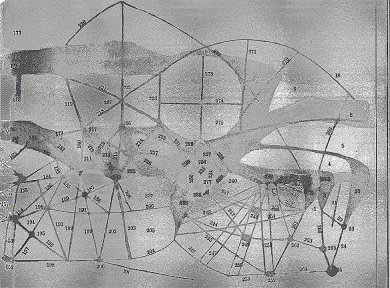
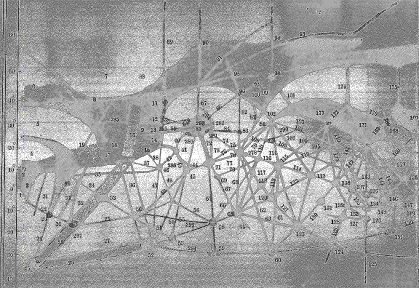
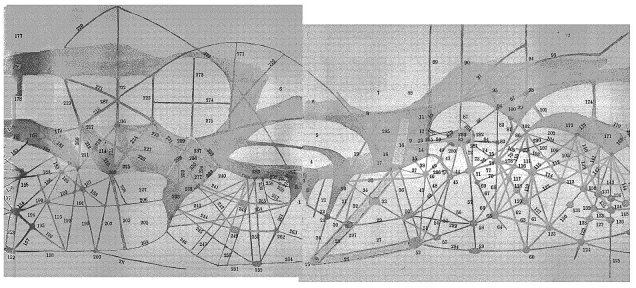
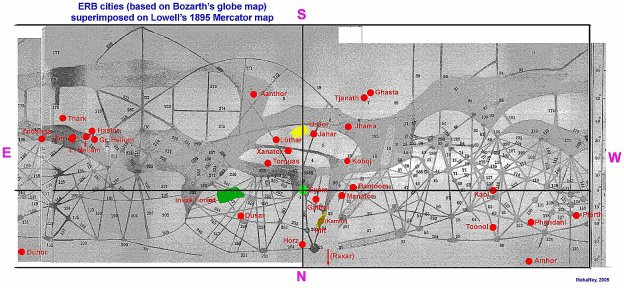
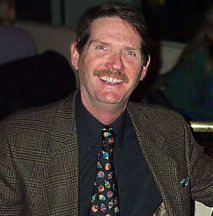 Leathem Mehaffey is a professor of biology at Vassar College in Poughkeepsie,
New York. A graduate of Columbia University, he did his Ph.D. in biophysics
at The Ohio State University and his postdoctoral work in vision at Harvard
Medical School. Professor Mehaffey has been at Vassar since 1973,
primarily teaching neurobiology and physiology. His main research interest
is the cellular mechanisms of vision.
Leathem Mehaffey is a professor of biology at Vassar College in Poughkeepsie,
New York. A graduate of Columbia University, he did his Ph.D. in biophysics
at The Ohio State University and his postdoctoral work in vision at Harvard
Medical School. Professor Mehaffey has been at Vassar since 1973,
primarily teaching neurobiology and physiology. His main research interest
is the cellular mechanisms of vision.


